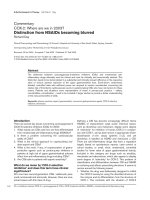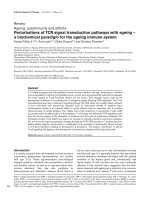Báo cáo y học: "GOAL: What Have We Learned" pps
Bạn đang xem bản rút gọn của tài liệu. Xem và tải ngay bản đầy đủ của tài liệu tại đây (161.27 KB, 3 trang )
117
A recent study entitled “Can Guideline-Defined
Asthma Control Be Achieved?”
1
stands out as one
of the most noteworthy clinical studies of the past
year because of the important concepts it confirms
and because of the many significant questions it
raises. Published online in July 2004 and in print
in October of the same year, it is referred to by most
as the GOALtrial (from the now familiar acronym
for “Gaining Optimal Asthma controL”). Based on
what we have learned from the GOAL trial, it is
likely that the next iteration of asthma guidelines
will be somewhat more stringent in their acceptance
of symptoms that define “well-controlled asthma”
or “acceptable control.”
To fully appreciate the study, it is necessary
to highlight two previous hypothesis-generating
studies
2,3
that led to the development of the GOAL
trial protocol. In the first of the two studies, the
authors pooled data from eight trials using inhalers
containing combined salmeterol and fluticasone
propionate.
2
The data were reanalyzed with a new
endpoint based on a composite measurement of
asthma control as defined in guidelines published
by the Global Initiative for Asthma (GINA). This
was the first time a composite endpoint based on
current asthma guidelines was used, as opposed
to the majority of asthma studies to date, which
have selected single-variable endpoints. The results
of this analysis indicated that guideline-defined
asthma control can be achieved and led to the
development of a prospective protocol using the
composite measure as the endpoint. The second
hypothesis-generating study also indicated that
improved quality of life was realized as the level
of control improved, control again being defined
by a guideline-based composite measure.
3
A
significant observation across both studies was that
similar proportions of individuals were achieving
the same levels of asthma control
2,3
and improve-
ments in quality of life
3
in the populations studied,
regardless of the severity of asthma. This sug-
gests that patients with more severe asthma should
be taught to expect the same level of control and
the same quality of life as those with milder
asthma.
The GOALtrial was then developed as a “proof
of concept” that asthma control according to the
GINA guideline-based definition is achievable.
The primary objective of the study was to compare
the proportion of individuals who achieved a com-
posite guideline-based measure of well-controlled
asthma by using an inhaled corticosteroid alone
with the proportion of those who achieved the
same by using an inhaled corticosteroid in com-
bination with a long-acting  agonist. The patients
were stratified before randomization, according
to their prior exposure to inhaled corticosteroids.
Patients in each stratum were started on an initial
dose of fluticasone, and approximately half were
also given salmeterol in a combination device.
There were up to three treatment steps, depending
on the stratum, during which the dose of inhaled
corticosteroid was escalated to a maximum of
1,000 g of fluticasone propionate per day if
patients did not meet the protocol-defined criteria
for total control. If the composite measure of total
control was achieved, the patient remained on the
same dose until the completion of the 52-week
study. If protocol-defined total control was not
achieved by the time the patient reached the max-
imum dose, the maximum dose was continued
until the end of the study.
Editorial
GOAL: What Have We Learned?
Timothy K. Vander Leek, MD, FRCPC
Division of Clinical Immunology and Allergy, Department
of Pediatrics, University of Alberta, Edmonton, Alberta
Correspondence to: Timothy K. Vander Leek, MD, 903
College Plaza, 8215–112 St., Edmonton, AB T6G 2C8;
E-mail:
118 Allergy, Asthma, and Clinical Immunology / Volume 1, Number 3, Fall 2005
Individual parameters used by various world-
wide asthma guidelines in defining asthma con-
trol have, for the most part, been separately vali-
dated in previous studies. However, until this
study was completed, the determination of which
parameters were used to create a composite def-
inition of asthma control was based primarily on
expert opinion. The GOAL trial is the first large-
scale (n = 5,068) long-term (1 year) prospective
trial that proves that guideline-defined composite
measures of asthma control are achievable.
The results of this study may change our prac-
tice by asking us to reconsider our current accep-
tance of the presence of some symptoms as “ade-
quately controlled.” The study creates confidence
that high levels of control not only can be achieved
but can be maintained for up to a year, with the asso-
ciation of significant improvements in quality of
life. Bateman and colleagues, quoting Cockroft
and Swystun, stated that “for patients with more
severe disease, many physicians equate therapeu-
tic success with a reduction in symptom severity,
rather than aiming for optimal control.”
2,4
Clearly,
this is no longer acceptable. It is likely that there
will now be an increase in the stringency of asthma
guidelines in their definition of control. Ameasure
of an amount of improvement from baseline may
show statistically (and sometimes clinically) rel-
evant results, but a more meaningful measure of a
treatment’s success is how close a patient can get
to the “ceiling” (ie, the extent to which the goal of
therapy has been met).
2
As Bateman and colleagues
discussed, this will lead not only to better clinical
management of asthma but also to the use of a com-
posite measure to define asthma control in future
studies, which would allow better comparisons of
study results and treatment modalities.
2
The use of
single criteria as markers of response to treatment
favours a positive response whereas a composite
measurement of asthma control is more stringent.
The latter may be a truer measurement of asthma
control, but it is important to note that it may also
problematically underestimate a true positive
response to treatment. In a recent editorial, Red-
del pointed out that with a composite measure,
there is a “lack of specificity of most of the clini-
cal features of asthma, manifest by overlap with
concurrent conditions.”
5
In Reddel’s examples,
cough from postnasal drip or shortness of breath
from lack of physical fitness would cause an indi-
vidual to fail the composite measure of control as
defined by the GOAL trial but would not respond
to increased doses of inhaled corticosteroid.
5
Clearly, a more stringent composite measure of
asthma control does not negate the importance of
good clinical judgment in practice. Asthma is a syn-
drome (ie, a collection of symptoms) that may
have different causes and an underlying patho-
physiology (eg, eosinophilic versus neutrophilic
inflammation, allergic versus nonallergic). There-
fore, asthma may not respond equally well in all
individuals to the same treatment modalities. In
addition, although the GOAL study challenges
one to strive for total control in the management
of asthma, it is important to note that a significant
portion of study participants did not achieve total
control. It is clear that an inhaled corticosteroid and
long-acting  agonist alone are not sufficient for
all patients and that other treatment modalities
may be necessary.
It is important to note that the GOALstudy was
not designed to validate a certain strategy for dose
escalation or frequency of patient follow up, and
it did not compare different strategies for gaining
control. The protocol used for escalating therapy
in the GOALstudy was meant to mirror common
practice and guideline recommendations, but the
results should not be taken to indicate that the
same regimen is universally appropriate. The
results actually reveal that there was continued
improvement in each group over time even while
subjects were taking lower doses of inhaled
corticosteroid, suggesting the possibility that
longer intervals of treatment are needed before
increasing or stepping up therapy.
The GOALstudy indirectly confirms the prior
understanding of the advantage of add-on therapy
with a long-acting  agonist as opposed to mere
increased doses of inhaled corticosteroid. A sim-
ilar proportion of individuals achieved control
with lower doses of inhaled corticosteroid, using
combined inhaled corticosteroid and long-acting
 agonist. However, although a similar proportion
of individuals also reached comparable levels of
control more quickly with the combination, the
study does not confirm that the more expensive
GOAL: What Have We Learned? — Vander Leek 119
combination inhaled corticosteroid/long-acting
 agonist devices are needed as initial therapy
for all individuals. As Barnes discussed in an
accompanying editorial, the differences in rates of
improvement were small, and the results seen in
the steroid-naive group reinforces current recom-
mendations that inhaled corticosteroids alone be
used as initial treatment.
6
He added that “it will be
a matter of debate whether these differences jus-
tify the additional cost” of a combination device.
6
In addition, although initial attempts to achieve
total control as defined by the study may neces-
sitate escalating doses of inhaled corticosteroid, the
GOAL study was not designed to justify pro-
longed maintenance on high doses. As previously
mentioned, there was a noted continual improve-
ment over the 52 weeks of the study and a simi-
lar rate of improvement across all groups, sug-
gesting a steroid effect. The study results also
show that the high doses used contributed to a mea-
surable clinical benefit, as a greater proportion of
patients achieved better control by 52 weeks. Fur-
ther benefits were also found during a final treat-
ment phase that included oral corticosteroids and
high-dose combination inhaled therapy for those
whose asthma was not totally controlled as defined
by the study. This challenges the thought that
there is no benefit to escalating inhaled corticos-
teroid doses beyond the moderate-dose range.
Admittedly, the degree of benefit decreased as
the dose increased, and it is important to recog-
nize that maintaining individuals indefinitely at
higher corticosteroid doses not only increases the
potential for adverse effects but also increases
asthma care costs by using more medication. What
is not clear from this study is how high to esca-
late doses or how long to continue high-dose
inhaled corticosteroid therapy before accepting
the level of control achieved and stepping back to
maintain it. Further study is certainly needed to
determine how high to go and when to begin step-
ping down the dose. One must also be mindful that
because the study does not compare different
medications within the same class and does not
compare different types of delivery devices, one
cannot infer from the results that one medication
of the same class or a certain delivery device is
superior to another.
We are clearly in a phase of understanding
asthma in which we can begin to fine-tune asthma
management rather than focusing merely on the
palliation of a chronic incurable condition. The
GOAL trial may begin to shift our current defin-
ition of acceptable asthma control, causing the
development of more stringent guidelines and
challenging us to strive for better levels of symp-
tom control in our patients.
References
1. Bateman ED, Boushey H, Bousquet J, et al.
Can guideline-defined asthma control be
achieved? The Gaining Optimal Asthma
Control study. Am J Respir Crit Care Med
2004;170:836–44.
2. Bateman ED, Bousquet J, Braunstein GL. Is
overall asthma control being achieved? A
hypothesis-generating study. Eur Respir J
2001;17:589–95.
3. Bateman ED, Frith LF, Braunstein GL.
Achieving guideline-based asthma control:
does the patient benefit? Eur Respir J
2002;20:588–95.
4. Cockroft DW, Swystun VA. Asthma control
versus asthma severity. J Allergy Clin Immunol
1996;98:1016–8.
5. Reddel HK. Goals of asthma treatment: how
high should we go? Eur Respir J 2004;
24:715–7.
6. Barnes NC. Can guideline-defined asthma con-
trol be achieved? The Gaining Optimal Asthma
Control study. Am J Respir Crit Care Med
2004;170:830–1.









